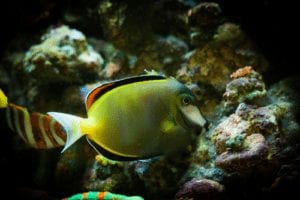Powder Brown Tang

Onyx black dorsal and rear fins frame the Powder Brown Tang’s uniquely narrow yet disc-shaped body. Tiny red spots appear on the male just below the pectoral fin, or long red or yellow stripes can outline the black meeting at the end in its distinctive wish-bone shape. It can only be described as a truly elegant looking fish enjoyed by experts across the world. Its juvenile colorings are largely a sandy, taupe color giving the Tang its name. But don’t be surprised by this powder brown tang, as this temperamental fish can change most of its body coloring depending on mood or environment.
Also known as the Powder Brown Surgeonfish, Japan Surgeonfish and White-faced Surgeonfish, it is typically found in the Indo-West Pacific region. Specifically, the southern islands of Japan, Ryukyu Islands to Taiwan, Sulawesi (Indonesia) to the Philippines, and have been spotted as far east as the Hawaiian Islands. In the wild, they travel in large schools and usually remain in the shallow waters near the coast or even estuaries and harbors.
Tank Requirements for the Powder Brown Tang
Tangs need plenty of room to swim and maneuver so a 125-gallon tank or larger is recommended. The fish can be seen as passive with most livestock in your tank but when it comes to other tangs, all bets are off. They become very aggressive toward one another and will fight. The competition for food and territory will not end well for the less dominant. For this reason, it is recommended to keep only one per tank.
Caring For & Acclimating Your Powder Blue Tang
Powder brown tangs are known to be rather delicate and do have a difficult time acclimating to a new environment. It is not fully understood why this tang has more difficulty, but the stress placed on it during shipment or changes in water quality certainly are contributing factors. For this reason, a slow acclimation process will increase the likelihood of success. Even if your tank is placed in an area with a lot of movement or foot traffic, it can cause undue stress on the tang’s system. It is recommended that only intermediate or advanced aquarist care for the powder brown tang. A rigorous filtration regime will be necessary along with protein skimming and complete water changes.
Feeding Requirements of Tangs
Tangs are omnivores, they can digest meat and will occasionally seek this out. Their diet in the tank, however, should lean heavily toward marine-based plants, specifically algae. This should be supplemented by seaweed. Sheets of seaweed should be submerged and tied to a rock or feeder. The tang will become familiar with this and graze as it pleased. Dried pellets infused with vitamins will provide the fish with necessary nutrients and help fend off diseases. They may also take frozen brine and mysid shrimp for protein. Live rock with micro and macro organisms are another great idea that will keep the fish healthy and happy.
The plant-based food, it should be noted, is known to be better for the tang’s overall health. Not only will it improve its immune system but may even causing it to be less aggressive. They should be fed three times a day.
Powder Blue Tang Care Requirements:
- Care Level: Moderate
- Temperament: Semi-aggressive
- Color Form: Red, Tan, Yellow
- Diet: Omnivore
- Water Conditions: 72-78° F, dKH 8-12, pH 8.1-8.4, sg 1.020-1.025
- Reef Compatible: Yes
- Origin: Indian Ocean/ South Pacific
- Family: Acanthuridae
- Minimum Tank Size: 125 gallons
View the care requirements of other marine fish.

















